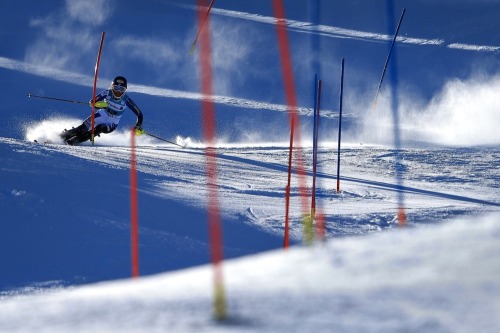Not the gut to follow silly exibition or pictures from holidays or whatever...
The world of sport (and betting) goes on somewhere else.
Alpine skiing is one of my favourite sports, my favourite winter one, and I've always followed and watched it.
First, very simple, they start from "the top", go down the slope and cross the finish line. The one who's took less time to complete the way down wins.
But...
1a - On you're way down you must pass through "gates", meaning that both the skis must be on the same side of the gate - the right one.
1b - Not always you go down, take you're time, and it's done. Sometimes there's a second run to be done. And the sum of the times of both runs gives the total time, the smaller wins.
The 1b fact is because there are four event: Downhill, Super-G, Giant Slalom and Slalom. There are also Combined (Downhill + Slalom), Super-Combined (Super-G + Slalom) and City Event (on this there still be confusion and things to decide).
 |
| I don't know if it's clear the inclination |
It's the faster event, you just need to create speed, keeping an aerodynamic position.
It's very spectacular, with turns faced up at high speed, long jumps and also (sometimes terrible) accident.
They can reach 200 kph.
Before every official race there are time trial so you know the slope and all the most crucial points.
It's the longest event though, say over two minutes to complete the race.
There's no second run, after you've skied down and through every gate you've got your time and can wait for the other make their race.
 Super-G is a mix of Downhill and Giant-Slalom.
Super-G is a mix of Downhill and Giant-Slalom.There are more turns, so the speed in lower than in the downhill.
Gates are at a bigger distance compared to Giant Slalom so in between the gates you increase your speed.
What makes Super-G particular is that there are no test before the race so you've go to "improvise".
Also here race are made only of one run.
Downhill and Super-G are "the fast disciplines" and usually athletes compete in both.
 Giant Slalom is the mother of all disciplines, usually when you start skiing that's the one you're first introduced to.
Giant Slalom is the mother of all disciplines, usually when you start skiing that's the one you're first introduced to.Gates are very close - from 30 to 20 meters - and every gates means a change of direction.
A race is made by two runs. At the end of Run1 the top 30 qualify for Run2.
In Run2 the starting order is reversed: first starting athlete is 30th place of Run1, then 29, 28... last to take the start is 1st place of Run1.
 Slalom is the most technique event, a lot of gates - around 60 - in a short slope.
Slalom is the most technique event, a lot of gates - around 60 - in a short slope.There aren't high speeds but a great footwork is needed.
Turns aren't always left-right-left-right but there are tricks or "figures", as they're called, too.
Two runs with reversed order in the second one as said above.
Anyway at high level is difficult to be a top contender in all four, as you can imagine; so athletes are specialist of only one, max two disciplines.
 |
| This could give the size of each event. *DH = Downhill GS = Giant-Slalom SG = Super-G SL = Slalom |
Otherwise it would be hard, and esthetically embarassing - I assure you -, to see a downhill specialist in a slalom and the other way around; because different skills are required in every event.
To better understand, comparison with tennis could be very useful: the four specialities of alpine skiing could be thought as the four surfaces of tennis, then there's the tennis racket/skis comparison and other more specific.
More things to come about the standings, the starting list, and above all the odds and markets.
No comments:
Post a Comment